We're back. Predictably, it's great to be home, despite the scramble to do taxes!
Rick and Gary meet South America
A three month journey to Ecuador, Uruguay, and Argentina.
Thursday, April 13, 2006
Friday, April 07, 2006
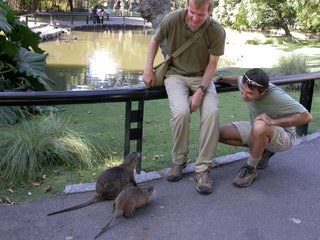
How big are the rats of Buenos Aires? Pretty big! Actually, these are another type of rodent that wander around freely (along with a lot of other animals) at the Buenos Aires Zoo.
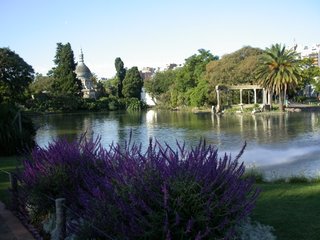
This is Darwin Lake near the entrance to the zoo, which is really nicely done. The Buenos Aires Zoo is the only one of the many zoos we have visited in which one can still buy food and feed many of the animals. While seeing wildlife in captivity is not our idea of enjoying nature, it gave us the opportunity to see many species found only in South America and not seen in North American zoos.

The prospect of being fed makes the animals really friendly with visitors, especially if they smell zoo food on you. A hyena came running up to Rick from the bushes in its cage. No, it wasn´t because the hyena thought Rick a fellow member of the species. It was because a woman about 40 feet behind Rick had zoo food on her and the hyena caught the sent.
These dogs were not at the zoo. Rather, they were waiting for their professional dog walker.
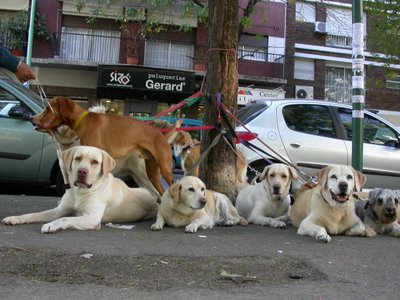
Thursday, April 06, 2006
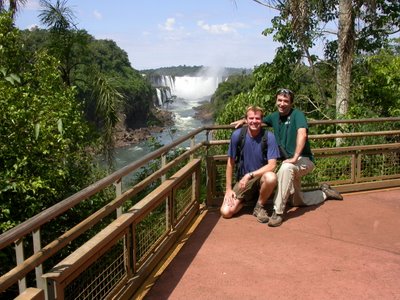 Iguazu Falls, on the border of Argentina, Brazil, and Paraguay is our last big trip before leaving Buenos Aires for Boulder, Colorado.
Iguazu Falls, on the border of Argentina, Brazil, and Paraguay is our last big trip before leaving Buenos Aires for Boulder, Colorado.
More water passes through these falls then any other in the world, an average of 553 cubic feet per second. There are 275 cascades spread over two miles. Argentina has preserved a huge portion of its land adjacent to the falls as a national park. We were fortunate enough to stay in the only hotel within the park boundaries. We had a view of the falls in the distance -- Very scenic. The falls are spectacular, especially the largest one named Devil´s Throat, pictured to the left. The park has several trails leading to various viewing areas. Eleanor Roosevelt commented on the falls when she visited: "Poor Niagra"
These cute furry racoon-like animals crossing on the catwalk railing are coati. They seemed unconcerned with people standing within inches of them as they foraged for food, then made there way across the bridge. The park has signs warning against feeding the coati because they will bite.
Saturday, April 01, 2006

Rick´s bad internet cafe experience doesn´t reflect the entire Urugauy excursion, although it highlights some of the anti-U.S. sentiment we have experienced. The little tourist town we visited in Uruguay of Colonia del Sacramento was declared a UNESCO World Heritage Site in 1996. The old town has many historical buildings and the original cobblestone streets built by the Portuguese or Spanairds settlers. An interesting bit of trivia is that you can tell who built which street by the type of drainage it has -- the Portugeuse placed drains in the middle and the Spanairds placed drains along the sides.

We rented bicycles and rode along the beaches to a rather odd place called "Real de San Carlos". Apparently an Argentine playboy built this leisure complex during the early twentieth century, complete with bull-fighting ring, basketball or pelota court/theater, hotel, and horse racing track. The bull ring pictured here was only used eight times before bullfighting was outlawed but the ruins remain standing.

We had the opportunity to try a new type of wine with our great steak dinner while in Colonia. They produce a very rich red from the tannat grape. I believe the only other place to grow it is in the southwest of France where it is blended with other grapes. Uruguayans love beef every bit as much as Argentines and this 100% tannat wine complements grilled meat well. After a couple of days in Uruguay we returned to Buenos Aires and wandered along Puerto Madero for a couple of hours. The Argentine economy appears to be on the rebound and there is no place that reflects it more than this regentrified port. There are loft apartments above trendy restaurants and shops for several kilometers. We enjoyed the "cow art" along the walkway.
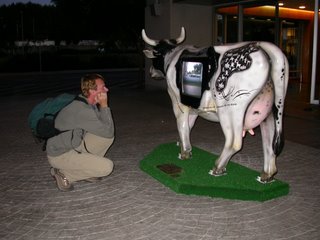

This blog entry would not be complete without sharing Rick´s version of the famous Evita pose at Casa Rosada, the presidential palace in Plaza de Mayo. The balcony has been used by many of the dictators and demagogues that fill Argentina´s history. Rick was very disappointed that he was unable to gain access to the balcony for the photo like Madonna did for the film Evita.
He pulled off a great pose, however, as the onlookers and policemen in the plaza could see. Don´t cry for Rick, Argentina....

Friday, March 31, 2006
We´re back from Uruguay. When I (Rick) signed in to an Internet cafe in Colonia, Uruguay, the fellow managing the business made a point of playing a video of the 9/11 bombing at ear-peircing volume, with him and his friends laughing about as loudly as humanly possible. I presume that this was intended for me, since, while I spoke Spanish to him (in extremely polite terms), he answered me abrubtly in English.
Wednesday, March 29, 2006
We are headed to Uruguay today, taking a boat across the Río de la Plata. We should be back in Buenos Aires on Friday.
Sunday, March 26, 2006
Argentina´s conflicting identities seem to us to be extraordinary. By their own popular history, there is the conflict between the "sophisticated" metropolis/capitol Buenos Aires and the rural cattle barrons that control the power in Buenos Aires. There is also:
-- the aspiration to be a Europrean nation (with the Itialian blood and lingual influence) versus the geography and authoritian klepto-culture that set it firmly in South America.
-- the expansionary, triumphalist military claiming the Falkland Islands and part of Antactica vs. the impotence in warring with second-class power Great Britian, let alone the U.S., a nation it once regarded as a rival and is now the world hegemon.
-- the money and style for which it yearns vs. the financial humilation of the November 2001 bank crisis, and currency devaluation.
In some ways, this is the U.S. that failed. As China and India take over global dominance, and we suffer decline at home, this may also be our future, faded glory.
Friday, March 24, 2006

Professional dog walkers are big here in Buenos Aires.

It´s amazing how they can walk eight to ten large dogs and never get their leashes crossed. A constant and not completely unexpected hazard of this practice, however, is the frequent risk of stepping in the "remnants" of their path. It is wise to keep looking down when walking the sidewalks of B.A.!!
Thursday, March 23, 2006

Buenos Aires is really terrrific
Nice, classy people, great food, beautiful parks and architecture -- these are our impressions of Buenos Aires for the first 2 full days. Of course, it is also very inexpensive for holders of US dollars. We have not checked out the nightlife yet, but that is what this city is famous for. We were at the Eva Peron museum today and then went and checked out her grave, which is at the Recoleta Cemetery, a breathtaking necropolis where all of Argentina´s dead big wigs hang out.
The Peron museum was OK. Located in an old house that Evita had Juan apropriate for a women´s shelter during the 1940´s, it contains many dresses she wore during photo ops of eventful poltical affairs (very stylish) and plenty of memorabilia from the propaganda machine for which the Peron´s were known. But not at all campy, like, say, the Liberace museum in Las Vegas. We did not realize that after her death from ovarian cancer at age 33 her corpse had been kidnapped, was missing for many years and later found buried under a false name in Italy, returning to Argentina 20 years after her death and setting off a riot. Somewhere along the way her body was partially mutilated, which was described in a gruesome recorded monologue to Evita´s corpse by her sister. She has had a more eventful career as a dead person than most people have while they are alive.
 All this and a hit musical, too! Here Gary is in the Recoleta Cemetery, looking for Eva Peron´s elusive corpse.
All this and a hit musical, too! Here Gary is in the Recoleta Cemetery, looking for Eva Peron´s elusive corpse.
Wednesday, March 22, 2006
Day one in Buenos Aires
The burglar whom Bonnie thwarted matches the description of the North Boulder burglar published in the newspapers -- 5´9", black hair. Hopefully, he won´t want to tangle with Miss B a second time!
Here in Buenos Aires, Fall is in the air. The evenings are breezy and cool, and the leaves on the tree-line streets are just starting to turn.
The city had a really hot, humid summer, followed by heavy rains just before we arrived, so everyone seems in a up mood with the advent of pleasant weather. We have not had much time to walk around, having arrived late last night, but this does seem to be a beautiful city, in a faded glory kind of way. The beautiful 1920´s buildings from the city´s economic peak are well maintained. That´s a big difference from Havana, where the 1930´s buildings from their golden era have become dangerous slums under Castro.
Yesterday, we went to Mendoza´s natural history museum, which is housed in a 1920´s art-deco building that is was made to evoke a ocean cruiser. Unfortunately, that building was poorly maintained, with broken windows, dilapidation, etc. The exhibits were pretty cool, despite petty swipes at the U.S., such as referring to us as "the United States of Northamerica" and displaying a map titled "America" which pretented that no land exists north of Mexico and Cuba.
It´s interesting that the two most hostile places that we have been to -- Otavallo, Ecuador, and Mendoza, Argentina -- are the two places that are relatively prosperous on account of exports to the U.S. -- Indian crafts from Ecuador and wine from Argentina.
Monday, March 20, 2006
We´re headed to Buenos Aires tomorrow.
One of our housesitters, Richard, emailed us today to say that last Thursday night/Friday morning at 2:30 am, Bonnie started barking, calling Richard´s attention to a man who had opened our side gate and was standing at our French doors. He ran away when he saw Richard. Here´s what the Colorado Daily wrote about a bulglar in our neighborhood:
The string of burglaries began on Valentine's Day last month and are anchored in central and north Boulder. The suspect forces his way into homes by kicking in the front door or throwing a rock through a window and then unlocking it to get in.“He's taking things, but he's not taking large items,” said Boulder Police spokeswoman Julie Brooks on Monday. “In some cases, owners haven't been able to ID what is taken until later on when they notice it's missing.”
Brooks said the burglaries are of concern to police not just because of the loss of property, but because this particular burglar is willing to use violent measures to break into locked houses.“It's hard to predict what this person might do when confronted or when he gets in,” Brooks said. “His victims did everything right: they locked their doors and secured their residences.”
But they didn´t have Miss Bonnie on the beat!!
Friday, March 17, 2006
The Italian influence in Argentina is something that will probably be even stronger in Buenas Aires, but even in the mountain city of Mendoza it is striking. Many of the young men around here look like they are straight out of the old country, with the curly, silky black hair and Roman chins. Sometimes, it is hard not to answer people in Italian, given the Italian-like cadences in the Spanish of many people.

Something you will never see in the U.S. -- the opportunity to stick your arm a cage full of cougars at the local zoo. That is no problem in Mendoza, Argentina, where the zoo is really ingrated with nature, and where the liability lawyers are apparently scarce.
It is so refreshing to see that there are still some foreign places where the idiots are not completely insultated from the consequences of their actions. Ever wonder why George W. Bush, before becoming President, never traveled outside the United States? Now you know ;-)
 The number of vistors at the Mendoza Zoo was extemely low, with almost no children. So the animals were unusually playful -- very unsually playful for a zoo. The Mendoza Zoo is tiered up the side of a hill at a gigantic park, which has a great population of wild birds. It was really cool. One of the lioness was roaring, appareantly at what was going on at a near by cage -- the world´s oldest rythm, at lion-level amplification. .
The number of vistors at the Mendoza Zoo was extemely low, with almost no children. So the animals were unusually playful -- very unsually playful for a zoo. The Mendoza Zoo is tiered up the side of a hill at a gigantic park, which has a great population of wild birds. It was really cool. One of the lioness was roaring, appareantly at what was going on at a near by cage -- the world´s oldest rythm, at lion-level amplification. .A barber in Mendoza left what Gary calls a rat´s tail on
 Rick´s hair. I am going to keep it as a souvenir of Arengtina!
Rick´s hair. I am going to keep it as a souvenir of Arengtina!
Thursday, March 16, 2006
 Protestor have blockaded the roads in and out of Quito, Ecuador, just one week after we left it. They have also taken 15 soldiers hostage and forced the resignation of the Interior Minister! Boy, we can´t leave a country alone for just 5 minutes!!
Protestor have blockaded the roads in and out of Quito, Ecuador, just one week after we left it. They have also taken 15 soldiers hostage and forced the resignation of the Interior Minister! Boy, we can´t leave a country alone for just 5 minutes!!Here in Argentina, watching Patagonia´s glaciers crumble is big sport. The news carries highlights, and sometimes live feeds, of enourmous chunks of ice falling in the water to the shouts of partying tailgaters. Yep, President Bush, global warming is just a left-wing canard.
Wednesday, March 15, 2006
Dancing in Mendoza? We have been flabergasted by the lack of nightlife here. Despite being a big, populous city, Mendoza seems very conservative. We have walked all over town during the last week and have never seen a bar or nightclub.
Finally, last night, Rick hung out in the park with several transsexual prostitutes. They took him to a fantastic, eclectic dance club. So now we know.
Today, Rick has a tequilla hangover and has take the Fiat back to the rental agency with a flat tire, dented rim, and major scratches.

After we got some bad advice from the tourist office in Uspallata, we decided to return to Mendoza via "the drive of the year". Which is an unpaved road with 365 hairpin turns and spectacular scenery. We were told it was not a difficult route and small cars have no problem making it. Wrong. We set out in our rented Fiat and found after about an hour of driving in a geologically fascinating desert environment that the road turns into mostly sand with formidable hills. Well, Gary being one not to be deterred easily when faced with driving challenges, attempted unsuccessfully to continue onward, dispatching Rick to get behind the Fiat and push. One flat tire and several minor scratches later we gave up and (Rick) drove back on the paved route. As Rick so optimistically put it: "Nothing ventured, nothing gained."

Monday, March 13, 2006

We are in Uspallata, Argentina, a small moutain town on the Argentine-Chilean border. Its claim to fame is that this is the area where ¨Seven Days in Tibet" was filmed. The slogan on Uspallata´s welcome signs is ¨the city of the movie.¨ In climate, landscape, and flora, Uspallata is suprisingly similar to Grand Junction, Colorado, in the late summer, which is the season here right now. Uspallata is just below Mount Aconcagua, 22,841 feet, the tallest mountain in the Western Hemisphere. We made a short visit to one of our favorite Mendoza wineries, Bodega Weinert where we sampled and purchased some of their varietals . After a typical lunch at a "tenedor libre", an all you can eat buffet with more beef than you can imagine, we drove around some of the vineyards but were unable to visit any more of them without advance reservations. As we said before, Argentines take their afternoon seistas VERY seriously.

Our wonderful, wonderful housesitters, Charles and Richard, sent us a recent photo of Miss Bonnie, who is getting lots of exercise. A blow-by-blow account of Bonnie and her new toy is on a new feature, Miss Bonnie´s dog blog
At first glance Mount Aconcagua does not look particularly impressive despite being nearly 23,000 feet above sea level, but then you remember that the park entrance is higher than any of Colorado´s tallest peaks. This view is from the south side and very near the border with Chile. The south side is reported to be nearly impossible to climb, so most routes to the summit are from the north side.... and no, we did not attempt to climb it.
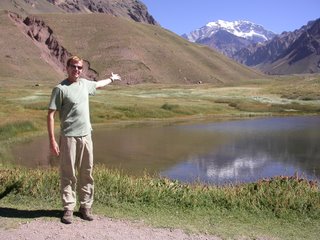

Sunday, March 12, 2006
We´re renting a car tomorrow and heading for the wine country that neighbors Mendoza. So far, the wine here has been excellent and outrageously inexpensive. The ice cream shop across the street for our apartment has Malbec flavor, as well as two other wine flavors! We should be able to post some photos of the Mendoza wine country on Wednesday.
Wednesday, March 08, 2006

What a difference Mendoza, Argentina, is to Ecuador. While we arrived only yesterday, it is really striking how different it feels to be someone that blends in to the crowd, whereas in Ecuador we really stood out as tall, pale-skinned Gringos.
So far, Mendoza has been a a really disorienting mix of the familiar and unfamiliar. (The disorientation is aided by the fact that both Gary and I are still experiencing rocking motions from having sailed the Pacific for 7 days.) Mendoza´s blue sky, gentle sun, neighboring mountains, and urban-town composure feel a lot like home-sweet Boulder in late Summer, right down to a leafy pedestrian downtown mall. Meanwhile, the dated architecture feels very 1950´s, as does the people´s very European concern for their public appearence in stylish dress and public grooming. No chance of seeing an obsese waddler in sweat pants here.
A interesting paradox is that while we stood out in Ecuador, we did not get many appraising looks, since we were just another pair of gringos. Meanwhile, in Mendoza we are getting lots of appraising looks because here everyone is checking out everyone else.
 Upon arriving in Mendoza, tired after about 12 hours of travel, we did something we have not done in more than a decade -- eat McDonald´s. It is shocking how good the meat in the McBurgers around here is. Argentina is a big cattle country, and Argentines really like red meat, so we are guessing that McDonald's cannot sell burgers here unless they use decent meat. It´s odd that some American consumer products are better abroad than at home. In addition to the McDonald´s tasting better, Coke does too - because in Latin America Coke is still made with sugar, not high-fructose corn syrup.
Upon arriving in Mendoza, tired after about 12 hours of travel, we did something we have not done in more than a decade -- eat McDonald´s. It is shocking how good the meat in the McBurgers around here is. Argentina is a big cattle country, and Argentines really like red meat, so we are guessing that McDonald's cannot sell burgers here unless they use decent meat. It´s odd that some American consumer products are better abroad than at home. In addition to the McDonald´s tasting better, Coke does too - because in Latin America Coke is still made with sugar, not high-fructose corn syrup.
 On the left is a downtown shopping mall at 2 pm on a weekday afternoon. People here take their siestas really seriously. All the stores are shutdown from 1 pm to 4 pm.
On the left is a downtown shopping mall at 2 pm on a weekday afternoon. People here take their siestas really seriously. All the stores are shutdown from 1 pm to 4 pm.
There seems to be a curiously large number of people in Mendoza limping, or walking around with the help of crutches or various types of braces. I have also seen quite a few shops that specialize in selling orthopedic supplies. I´m not sure what´s going on. The driver-safety standards do not seem to be any more insane here than anywhere else in Latin America. Most of the limpers (but not the folks with crutches or braces) were young men, which suggests that they may have been injured playing soccer. But again, young men play soccer all over Latin America, and this is the first place where I see so many limpers. Any ideas out there?
Finally, another odd, first impression is the extreme levels of public courtesy and rudeness. On the courtesy side, it is not unusual for strangers to open doors for us. In one case, a fellow passenger on an elevator insisted that I disembark before him, even though I was behind him in the elevator.
On the rudeness side, people can be comically aggressive about trying to cut in front of you in line. On the afternoon we arrived, I was waiting to buy a cup of fresh grape juice from a street stand. A girl of about 10 years of age came after me, used her elbow and shoulder to push me aside and get a more prominent spot at the counter, and started rapping her coin on the counter, hoping to get the sale person´s attention before I could.
In another case, Gary and I were at a market and while the cashier was making change on our purchase, a fellow came from behind us, slammed down the item he was buying, and started waving his money and asking the cashier to ring him up, in the apparent hope that the cashier would stop our transaction to service this fellow who just arrived at the counter. The cashier did not seem the least bit surprised at this behavior and simply ignored him.
Finally, at a barber shop, where I had been waiting for 15 minutes for a hair cut, an old guy came and successfully cowed the barber into taking him before me. I left.
Hey, for people tuning in who do not already know us, we also have other travel journals at our web site, rickandgary.com
Sunday, March 05, 2006

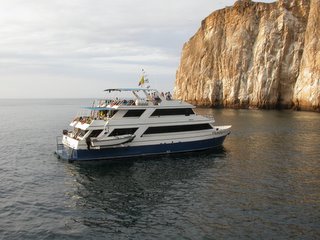 The room is rocking back and forth in Quito as I (Rick) sit at the computer at the Intenet Cafe. This is the after effect of being on this boat in the Pacific for 7 days. Neither of us had sea sickness, but boy there was a lot of rocking and my equilibrium has yet to recover.
The room is rocking back and forth in Quito as I (Rick) sit at the computer at the Intenet Cafe. This is the after effect of being on this boat in the Pacific for 7 days. Neither of us had sea sickness, but boy there was a lot of rocking and my equilibrium has yet to recover.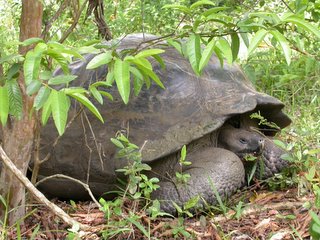
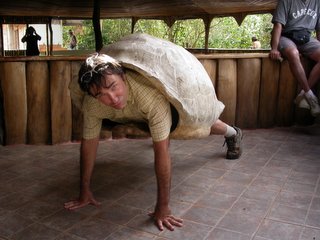
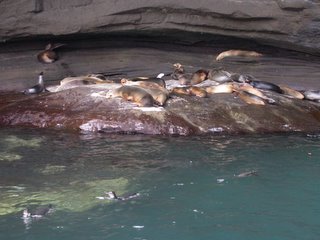 Here are sea lions resting on the rocks, with peguins swimming in front of them, followed by a sea iguana. Practically all the wildlife on the Galapagos has no fear of humans, basically because there has been a relatively small history of hunting by humans on these islands. It is a bit of the blow to the ego when iguanas will pay you no attention when you are one foot away, but will run under a rock if a hawk shows up 500 feet away. Baby iguanas make a tasty snack for the Galapagos hawk which is at the top of the food chain. The hawks will even eat sea lions when hungry enough.
Here are sea lions resting on the rocks, with peguins swimming in front of them, followed by a sea iguana. Practically all the wildlife on the Galapagos has no fear of humans, basically because there has been a relatively small history of hunting by humans on these islands. It is a bit of the blow to the ego when iguanas will pay you no attention when you are one foot away, but will run under a rock if a hawk shows up 500 feet away. Baby iguanas make a tasty snack for the Galapagos hawk which is at the top of the food chain. The hawks will even eat sea lions when hungry enough.Below is a marine iguana that Gary got a great shot of by
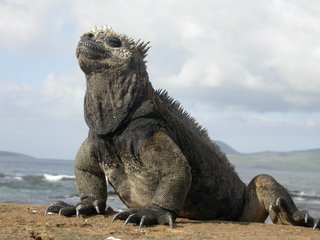 climbing under the ledge on which this iguana is sitting. While we liked these reptiles found only on the Galapagos Islands, Charles Darwin did not care for them. He thought they had a "stupid" demeanor and even called them "imps of darkness." There were places where they were so plentiful and unafraid of humans that we had to be careful to not step on them.
climbing under the ledge on which this iguana is sitting. While we liked these reptiles found only on the Galapagos Islands, Charles Darwin did not care for them. He thought they had a "stupid" demeanor and even called them "imps of darkness." There were places where they were so plentiful and unafraid of humans that we had to be careful to not step on them.These are the most pou
 lar birds on the Galapagos, with the catchy name blue-footed boobies. They are cutely awkward on land and will even do a little mating dance with you if so inclined. But they are incredibly graceful when dive bombing for fish. The islands are also home to the red-footed and Nazca boobies.
lar birds on the Galapagos, with the catchy name blue-footed boobies. They are cutely awkward on land and will even do a little mating dance with you if so inclined. But they are incredibly graceful when dive bombing for fish. The islands are also home to the red-footed and Nazca boobies.The island on the right is typical of the many volcanoes we sailed past, including Daphne Major where landmark studies on the evolution of finches were conducted by Princeton professors Peter and Rosemary Grant and described in the Pulitzer-winning book "The Beak of the Finch".

The islands are geologically young at a mere 20 million years for the oldest and are actively building on the youngest. The last eruption was in September, 2005.
The Galapagos penguin is the second smallest penguin in the world and the only species of penguin to live in tropical waters. The cool ocean currents make them endemic to only the two most western and youngest islands. Again, they are completely unafraid of humans. This photo was taken within three feet as our panga (small boat) past by several times with motor running and cameras clicking. 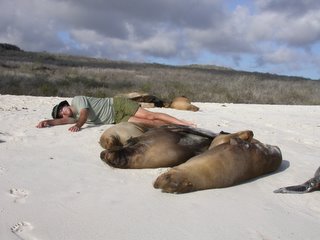
Another bunch of beach bums!
Friday, March 03, 2006
Greetings from the Galapagos Islands, 600 miles west of the South American continent. We are on Santa Cruz island, which is populated and therefore has a web connection. We will be posting photos on Monday after returning to Quito. Photos include Rick completely inside a shell formerly occupied by a giant tortoise, with his extruding head chewing on a local plant.
Saturday, February 25, 2006
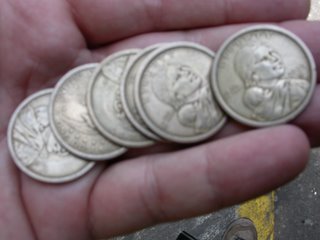 The most unpopular money in the U.S. is the most popular here. Ecuador uses the US dollar as its currency because its own currency collapsed about five years ago. The banks do not often replace US paper currency here, which can get really dirty. So, by far, the most popular money lady in Ecuador is Sacagawea . Although these one-dollar coins are practically non-existant in the country that mints them -- the United States, they are everywhere here in Ecuador.
The most unpopular money in the U.S. is the most popular here. Ecuador uses the US dollar as its currency because its own currency collapsed about five years ago. The banks do not often replace US paper currency here, which can get really dirty. So, by far, the most popular money lady in Ecuador is Sacagawea . Although these one-dollar coins are practically non-existant in the country that mints them -- the United States, they are everywhere here in Ecuador.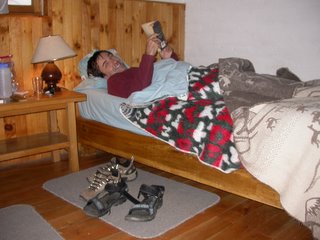 We are leaving early tomorrow morning for the Galapagos islands. We will be on a boat there for 8 days and will be back in Quito on March 5, and then off to Mendoza, Argentina, on March 6. Luckily, if all goes as planned, we will be back just in time for the Jon Stewart Oscars. We do not know if we will have any access to the Internet while we are on the Galapagos, which are mostly uninhabited islands 600 miles west of the South American continent.
We are leaving early tomorrow morning for the Galapagos islands. We will be on a boat there for 8 days and will be back in Quito on March 5, and then off to Mendoza, Argentina, on March 6. Luckily, if all goes as planned, we will be back just in time for the Jon Stewart Oscars. We do not know if we will have any access to the Internet while we are on the Galapagos, which are mostly uninhabited islands 600 miles west of the South American continent.
Thursday, February 23, 2006
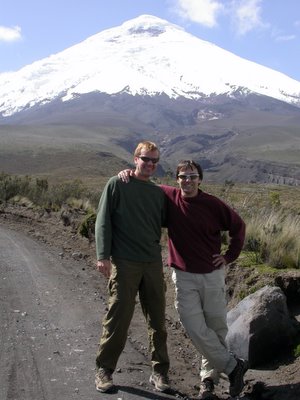
Hooray! The wonderful folks at blogger.com were able to restore our blog after Rick accidently deleted it.
We just returned to Quito from Cotopaxi, which at over 19,000 feet is the highest active volcano in the world (pictured above). We got a ride up Cotopaxi to just below the snow line and then went down it by mountain bike. 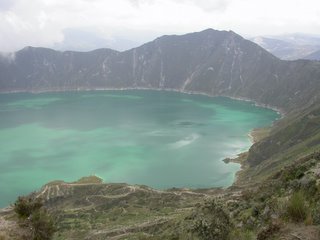
On the second day, we went with a wonderful Canadian couple, Brett and Corrie Olsen, to the crater lake of Quilatoa volcano. The highly alkaline water in the lake is a brilliant emerald green. There is a trail around the rim and a couple that lead into the crater. It was pretty easy to climb down into the crater, but it was really tough getting back out, especially when the afternoon rain set it. The altitude here is about 15,000 feet. whew!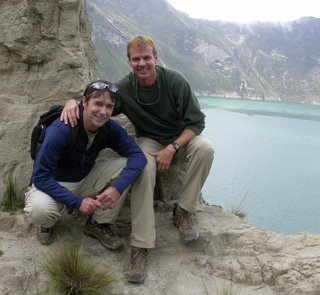
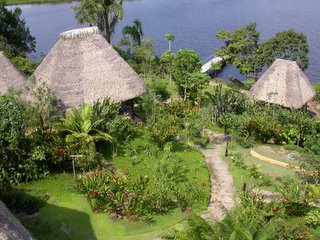
The previous week, while our blog was down, we stayed in the Amazon rainforest at the incredibly remote Napo Wildlife Center. There was a great variety of birds, monkeys, insects, and plant and water life. The guides were really happy to see us, since almost all the people who come here are too old to go on the really interesting trails, which can be physically challenging. On one trail we saw an eagle that even the guide, who has worked here for 7 years, had never seen. We saw more wildlife in this area than either of us have seen in other places combined. One night after our hike ended at dark, we paddled in a small stream with fishing bats flying around and caimans eyeing us a couple feet away among other interesting nocturnal creatures. Napo is one of only a few places in Ecuador where parrots come to eat the clay in order to detoxify poisons in their diet.

Above, parrots at a clay lick by the Napo River. On the right, our guide talks to Gary as we paddle in dugout canoes for an hour and a half through the Amazon rainforest to reach the lodge. This was after two and a half hours by motored canoes down the Napo River. Along the way a group of 20-30 squirrel monkeys followed along jumping from tree to tree. Snail kites were as common as the mosquitoes along this creek. Okay, maybe not THAT common but there were many of them. The water here is called "black water" because of a high tannin content from the surrounding plant life. Mosquitoes dislike breeding in black water, so they were not as plentiful as you might think for this part of the world.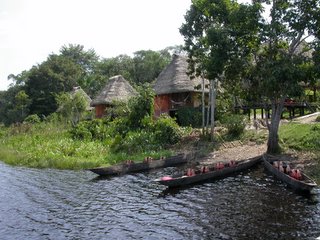
Our terrific guide, David, and Rick helped a dog at one of the clay licks. She had an infestation of worm-like fly larvae in her volva. These larvae are about half the length and girth of a child´s thumb and they litterly feed on the dog´s flesh in order to grow. Since the removal of these larvae are uncomfortable for the dog (but an extreme relief afterwards), we flipped her on her back and Rick kneeled over her head, keeping her mouth closed with his tighs and still having free hands to help remove the larvae. David pinched her flesh where the larvae was, forcing out its head. Rick then grabbed the head with a leaf and slowly pulled it out, all the while keeping the dog´s mouth from squirming out from between his thighs. We removed 11 larvae in about 30 minutes and basically saved the dog´s life.






